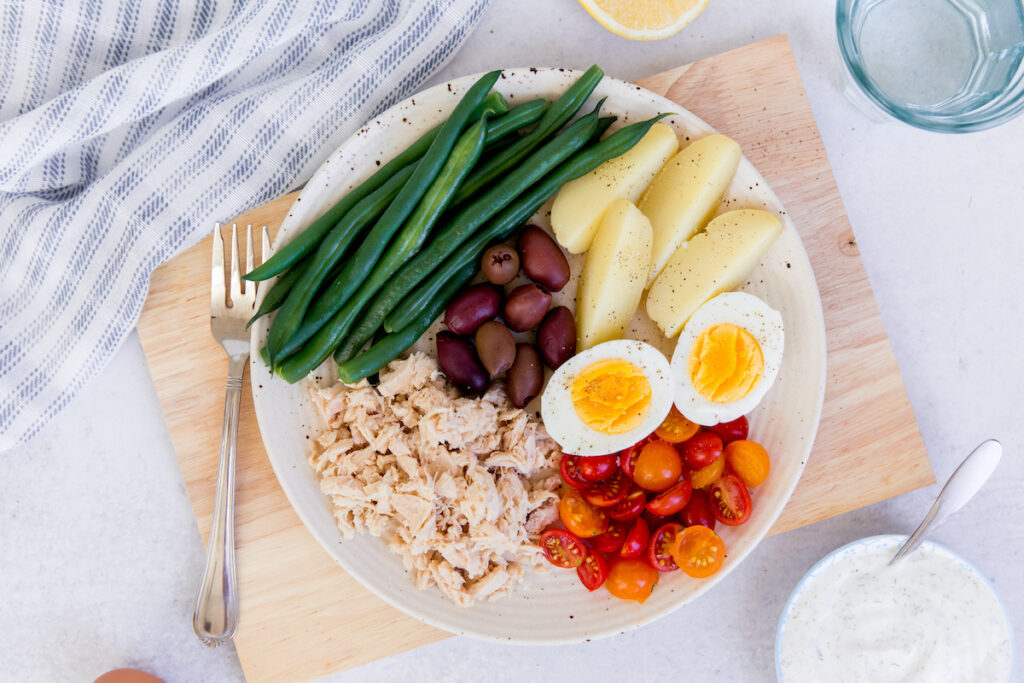As active trail runners, we tend to focus heavily on the macronutrients on our plates – protein, carbohydrates, and fats. There’s no doubt about it – eating the right amounts of macronutrients is vital for your health and running performance. However, we often forget about another aspect of our nutrition that is equally important – micronutrients!
These tiny but mighty compounds are the unsung heroes of your well-being, fueling your body and mind. In this article, I’ll delve into the importance of micronutrients for female trail runners, exploring how they can enhance your performance, boost your recovery, support your overall health, and keep you running those trails for years to come!
What are Micronutrients?
Micronutrients are vitamins and minerals that the body needs in small amounts to sustain whole-body health. Examples of micronutrients include vitamin D, calcium, magnesium, iron, and omega-3 fatty acids.
Conversely, macronutrients are nutrients that your body needs in relatively large quantities to be healthy; the main macronutrients are protein, carbohydrates, and fats.
Eating enough protein, carbs, and fats is vital for performing well as a trail runner. Your body uses carbs and fats as a fuel source during running and daily life. Protein is essential for building and maintaining your muscles and bones. However, even if your macronutrients are dialed-in, a micronutrient shortage could derail your running training, reducing your ability to adapt to training and even increasing your risk of injury.
Unless you are a healthcare professional, have worked with a dietitian or nutritionist, or have suffered from a nutrient-related health condition like iron-deficiency anemia, chances are you haven’t paid much attention to your micronutrient intake. It is crucial to start thinking about micronutrients if you want to feel and function your best on and off the trail!
As a sports nutritionist, I frequently help my clients optimize their micronutrient intakes, which often leads to improvements in their running performance and overall health. As an avid trail runner, I have also experienced firsthand the health benefits of optimizing my micronutrients!
Five Crucial Micronutrients for Trail Running Women
In my nutrition practice, there are five micronutrients that I like to focus on with my female athletes because of their fundamental important for whole-body health and athletic performance. The micronutrients include calcium, iron, magnesium, vitamin D, and omega-3 fatty acids.

Calcium
Calcium is a mineral that regulates nervous system signaling, including helping your muscles contract during daily life and exercise. Calcium is also a major structural component of your bone tissue; 99% of your body’s calcium is stored in bone (and your teeth). (Source)
It is crucial that runners eat enough calcium to support their bone density. Low dietary calcium intake is associated with an increased risk of stress fractures, a common injury among runners. Conversely, consuming enough calcium and vitamin D (vitamin D supports calcium absorption) may reduce the risk of stress fractures. (Source)
Women may be particularly at risk for low calcium intake. A recent study found that many female athletes aren’t eating enough calcium, averaging close to 535 mg of calcium/day rather than a more ideal target of 1,000-1,200 mg of calcium/day. (Source)
So, how can you determine whether you’re eating enough calcium? Unfortunately, measuring calcium in your blood isn’t a very useful way to assess calcium sufficiency. Your body tightly regulates calcium levels in your blood to keep you alive. Therefore, blood calcium levels aren’t significantly impacted by food and are not a good indicator of dietary calcium intake.
If you are uncertain whether your dietary calcium intake is sufficient, the best way to find out is to track your food for several days in a food tracking app such as Cronometer (I have no affiliation with Cronometer – I just find it a handy app!). As you enter food into the app, Cronometer will tally up how much calcium you have consumed so you can get a sense of your daily calcium intake.
Please note that food tracking is not recommended if you have an active eating disorder or a history of an eating disorder.
Next, you can focus on eating a variety of calcium-rich foods! Here are examples of foods rich in calcium:
- Dairy products, such as yogurt, kefir, and cheese. For example, one cup of yogurt contains around 450 mg of calcium.
- Dark leafy greens, such as kale, mustard greens, bok choy, arugula, and collard greens. One cup of kale provides 55 mg of calcium. Please note that while spinach contains calcium, the calcium it contains isn’t well absorbed because it is bound by another compound in spinach called oxalate.
- Cruciferous vegetables, such as broccoli and bok choy. For reference, one cup of broccoli provides ~60 mg of calcium.
- Tahini: Two tbsp tahini provide 120 mg of calcium
- Almonds: 1 serving of almonds (1/4 cup) provides 96 mg of calcium.
- Chia seeds: 2 tablespoons provide ~179 mg of calcium.
- Bone-in canned fish, such as canned sardines, provide about 200 mg of calcium per serving.
- Orange: 1 navel orange provides 60 mg of calcium
Ideally, we want to get as much calcium as possible from whole foods and only use calcium supplements as needed to round out our intake. (Source)
If you eat a dairy-free diet, you’ll need to be diligent about optimizing your calcium intake since dairy products are often the main source of dietary calcium for most people. Fortunately, as I mentioned above, there are many non-dairy sources of calcium to choose from.
Iron
Iron is a part of hemoglobin, the protein in your red blood cells that picks up oxygen from the air you breathe and delivers it to cells and tissues throughout your body. Iron deficiency reduces the body’s oxygen-carrying capacity, which is why it can significantly impair your athletic performance. Women are more susceptible to low iron levels than men due to the loss of iron that occurs during menstruation and differences in dietary intake or iron-rich foods. (Source)
A recent study found that 46% of female endurance athletes have suboptimal iron levels. This may impair athletic performance and have long-lasting adverse health effects, including fatigue. Signs of iron insufficiency include shortness of breath during exercise, fatigue, weakness, and frequent infections. (Source)
The RDA for iron for premenopausal women eating an omnivorous diet is 18 mg/day; for postmenopausal women, it is lower at 8 mg/day because your body is no longer losing iron via blood loss when you have your period. Importantly, the iron RDA is 1.8 times higher for vegans and vegetarians at 32 mg/day for premenopausal women and 14.4 mg for postmenopausal women because vegan and vegetarian diets provide less absorbable forms of iron compared to diets that include meat, poultry, and seafood.
Iron supplementation is often recommended for women with suboptimal iron levels or iron deficiency anemia. However, iron supplementation should only be used if you work closely with a health professional who can monitor your iron status because consuming too much iron can cause gastrointestinal distress and inflammation.
How can you figure out if you’re getting enough iron? Working with your doctor or a nutritionist to assess your serum iron and ferritin levels is an excellent place to start. Serum iron represents the iron directly in your bloodstream, while ferritin is a storage form of iron.
So, you’ve discovered you’re low in iron. What should you do next? Start with a food-first approach to increasing iron levels when possible. Iron is found in animal and plant foods; however, heme iron (the form found in animal foods) is the best-absorbed form. Plant foods contain a less absorbable form called non-heme iron. No vitamin or mineral is absorbed 100% when you consume it. In the case of iron, 25-30% of heme iron is absorbed, while only 1-10% of non-heme iron is absorbed. (Source)
People eating vegan and vegetarian diets are more likely to experience iron deficiency. Vegan diets contain only non-heme iron, while vegetarian diets may contain small amounts of heme iron from eggs. While it is definitely possible to get enough iron on vegan and vegetarian diets, it takes some forethought and planning.
Here are examples of foods that contain heme iron:
- 3.5 ounces of oysters provide 9 mg of iron
- 3 ounces of beef liver provides 6 mg of iron
- 3.5 ounces of beef provides 2.5 mg of iron
- 3 ounces of dark meat turkey offers 1.2 mg of iron
- 3 ounces of chicken provides 0.6 mg of iron
Here are examples of foods that contain non-heme iron:
- ½ cup of cooked lentils provides 3.3 mg of iron
- ½ cup of cooked spinach provides 3.2 mg of iron
- 3.5 ounces of pumpkin seeds provides 8.5 mg of iron
- ½ cup of broccoli provides 0.7 mg of iron
Magnesium
Magnesium is involved in over 300 chemical reactions inside your body, including pathways that make cellular energy to fuel your body during exercise. Low magnesium intake may contribute to fatigue, muscle cramps, and muscle weakness. Low magnesium can also contribute to anxiety and reduced stress tolerance in some people; I often find this to be the case in female athletes. In addition, research shows that athletes have higher magnesium needs than non-athletes. (Source, Source)
Magnesium levels in the blood aren’t usually a good indicator of dietary magnesium intake. Tracking your food intake for several days may be a more helpful way to determine whether you are eating enough magnesium. The RDA for magnesium is 310-320 mg/day for women, but athletes may need more because physical activity and sweating can increase magnesium losses.
Foods rich in magnesium include:
- Avocados: Half an avocado provides 29 mg of magnesium
- Almonds: 1 ounce of almonds provides approximately 75 mg of magnesium
- Cashews: 1 ounce of cashews provides 83 mg of magnesium.
- Pumpkin seeds: 1 ounce provides 74 mg of magnesium. Choose sprouted pumpkin seeds to get more bioavailable magnesium.
- Salmon: 4 ounces of salmon provides 31 mg of magnesium
- Leafy greens: 2 cups of collard greens provide 20 mg of magnesium
- Cacao powder: 1 tablespoon provides 27 mg of magnesium
Vitamin D
Vitamin D is a unique fat-soluble vitamin that our bodies produce when we expose our skin to the sun. Food is only a minor vitamin D source; foods that contain this vitamin include fatty fish such as salmon, egg yolks, and dairy products.
Vitamin D deficiency is widespread today. Studies suggest that nearly 30% of U.S. adults are vitamin D deficient, and 40% have vitamin D insufficiency, meaning they are not deficient (yet) but still have a suboptimal vitamin D level. (Source)
Low vitamin D levels may impair exercise performance and muscle repair and increase the risk of stress fractures, so maintaining an optimal vitamin D level is crucial for athletes! Vitamin D is also essential for calcium absorption, bone health, and immune function. Maintaining an optimal vitamin D level as an athlete may help circumvent respiratory infections! An ideal vitamin D level for athletes may be approximately 40 ng/mL – though more vitamin D than this isn’t necessarily better. (Source, Source, Source)
The ideal way to boost your vitamin D level is to spend time in the sun. You can use an app such as the D Minder app (no affiliation) to determine the optimal amount of time you should spend in the sun to make vitamin D.
You can also eat the vitamin D-containing foods outlined above to support your vitamin D level. However, even with these measures in place, it may be hard to maintain a healthy vitamin D level year-round. Many people need to supplement with vitamin D to maintain a healthy level. You should only take a vitamin D supplement if your level is low, so talk with your physician or nutritionist about getting your vitamin D level tested.
Omega-3 Fatty Acids
Finally, omega-3 fatty acids are essential fatty acids, meaning your body cannot produce them, so you must consume them through food. There are several times of omega-3 fatty acids, including alpha-linolenic acid (ALA), eicosapentaenoic acid (EPA), and docosahexaenoic acid (DHA). That’s a mouthful!
EPA and DHA are the most studied omega-3s in the context of sports nutrition. ALA can be converted into EPA and DHA inside the body. However, the efficiency of this conversion process can vary quite a bit from one person to the next. Some people aren’t efficient at converting ALA to EPA or DHA, which means they should consume EPA and DHA through foods like fatty fish.
Research shows that omega-3 fatty acids may improve endurance exercise capacity and support recovery by decreasing muscle inflammation. Omega-3s may be helpful for delayed onset muscle soreness, or DOMS. Research shows that female athletes may be prone to under-eating omega-3s in their diets. (Source, Source)
Try incorporating omega-3-rich foods into your diet throughout each week. If you’re curious to know your omega-3 level, you can work with your doctor or nutritionist to do a test called an “omega-3 index,” which measures the amount of omega-3 fatty acids in the membrane of your red blood cells.
Food sources of ALA include walnuts, chia seeds, and flaxseed. Food sources of EPA and DHA include various types of seafood, such as salmon and halibut, as well as grass-fed beef. If you’re not a seafood fan, getting EPA and DHA from a high-quality fish oil supplement is possible.

The Bottom Line on Micronutrients for Female Trail Runners
Trail running places unique demands on the female body. Long hours of running through rugged terrain require sustained oxygen delivery and energy levels, strong bones, and a healthy immune system. Optimizing your micronutrient intake is instrumental in achieving your trail running goals.
A nutrient-dense diet rich in vegetables, fruits, meat, poultry, seafood, nuts and seeds, dairy (if you tolerate it), and legumes is the ideal place to start for getting your micronutrients! If you have specific nutrient concerns, try teaming up with your doctor or a nutritionist who can create a personalized plan for you. When you get all the micronutrients your body needs, you will thrive on and off the running trail!
References
Coad, J., & Pedley, K. (2014). Iron deficiency and iron deficiency anemia in women. Scandinavian Journal of Clinical and Laboratory Investigation, 74(sup244), 82–89. https://doi.org/10.3109/00365513.2014.936694
de la Puente Yagüe, M., Collado Yurrita, L., Ciudad Cabañas, M. J., & Cuadrado Cenzual, M. A. (2020). Role of Vitamin D in Athletes and Their Performance: Current Concepts and New Trends. Nutrients, 12(2), 579. https://doi.org/10.3390/nu12020579
Hooks, M. P., Madigan, S. M., Woodside, J. V., & Nugent, A. P. (2023). Dietary Intake, Biological Status, and Barriers towards Omega-3 Intake in Elite Level (Tier 4), Female Athletes: Pilot Study. Nutrients, 15(13), 2821. https://doi.org/10.3390/nu15132821
Liu, X., Baylin, A., & Levy, P. D. (2018). Vitamin D deficiency and insufficiency among U.S. adults: prevalence, predictors and clinical implications. British Journal of Nutrition, 119(8), 928–936. https://doi.org/10.1017/s0007114518000491
Owens, D. J., Allison, R., & Close, G. L. (2018). Vitamin D and the Athlete: Current Perspectives and New Challenges. Sports Medicine, 48(S1), 3–16. https://doi.org/10.1007/s40279-017-0841-9
Pickering, G., Mazur, A., Trousselard, M., Bienkowski, P., Yaltsewa, N., Amessou, M., Noah, L., & Pouteau, E. (2020). Magnesium status and stress: The vicious circle concept revisited. Nutrients, 12(12), 3672. https://doi.org/10.3390/nu12123672
Ross, C., Taylor, C. L., Yaktine, A. L., & B, H. (2011). Overview of Calcium. Nih.gov; National Academies Press (U.S.). https://www.ncbi.nlm.nih.gov/books/NBK56060/
Sale, C., & Elliott-Sale, K. J. (2019). Nutrition and Athlete Bone Health. Sports Medicine, 49(2). https://doi.org/10.1007/s40279-019-01161-2
Sims, S. T., Mackay, K., Leabeater, A., Clarke, A., Schofield, K., & Driller, M. (2022). High Prevalence of Iron Deficiency Exhibited in Internationally Competitive, Non-Professional Female Endurance Athletes—A Case Study. International Journal of Environmental Research and Public Health, 19(24), 16606. https://doi.org/10.3390/ijerph192416606
Skolmowska, D., & Głąbska, D. (2019). Analysis of Heme and Non-Heme Iron Intake and Iron Dietary Sources in Adolescent Menstruating Females in a National Polish Sample. Nutrients, 11(5), 1049. https://doi.org/10.3390/nu11051049
Tenforde, A. S., Sayres, L. C., Sainani, K. L., & Fredericson, M. (2010). Evaluating the Relationship of Calcium and Vitamin D in the Prevention of Stress Fracture Injuries in the Young Athlete: A Review of the Literature. PM&R, 2(10), 945–949. https://doi.org/10.1016/j.pmrj.2010.05.006
Thielecke, F., & Blannin, A. (2020). Omega-3 Fatty Acids for Sport Performance—Are They Equally Beneficial for Athletes and Amateurs? A Narrative Review. Nutrients, 12(12), 3712. https://doi.org/10.3390/nu12123712
Wrzosek, M., Woźniak, J., Kozioł-Kaczorek, D., & Włodarek, D. (2019). The Assessment of the Supply of Calcium and Vitamin D in the Diet of Women Regularly Practicing Sport. Journal of Osteoporosis, 2019, 1–7. https://doi.org/10.1155/2019/9214926
Yoon, S., Kwon, O., & Kim, J. (2021). Vitamin D in athletes: focus on physical performance and musculoskeletal injuries. Physical Activity and Nutrition, 25(2), 20–25. https://doi.org/10.20463/pan.2021.0011
Zhang, H., Wang, R., Guo, S., Tian, Q., Zhang, S., Guo, L., Liu, T., & Wang, R. (2023). Lower serum magnesium concentration and higher 24-h urinary magnesium excretion despite higher dietary magnesium intake in athletes: a systematic review and meta-analysis. Food Science and Human Wellness, 12(5), 1471–1480. https://doi.org/10.1016/j.fshw.2023.02.015














